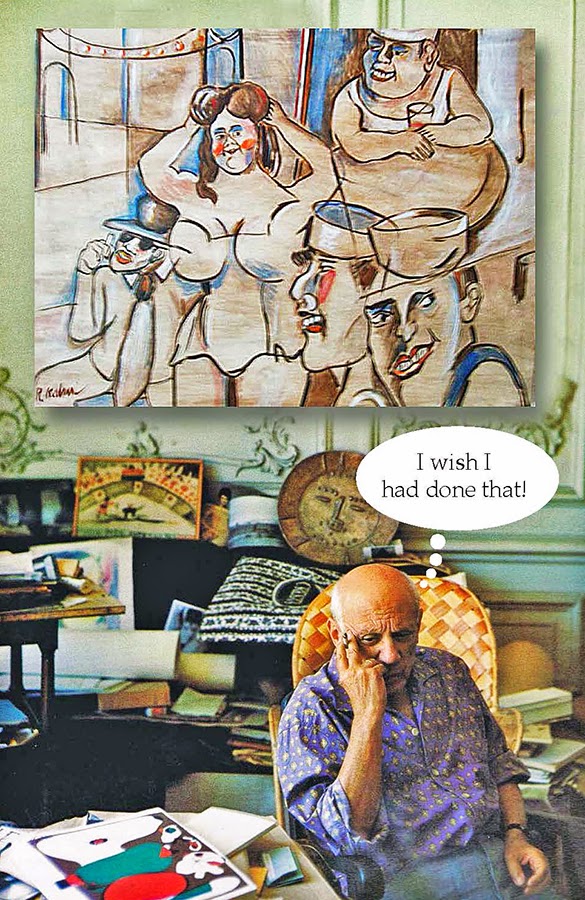 |
| (click on picture to enlarge) Photo-manipulation by Bob Callahan |
A friend of mine always
brings me the Life & Arts section of the London Financial Times, which I
have to admit is even better than the NY Times. I got a big kick out of their
art reviewer Jackie Wullschlager’s coverage of Jeff Koons’ new exhibit at the
Pompidou Centre in Paris, a version of the “blockbuster” at the Whitney last
summer, (which I deliberately avoided.) I’ve seen quite a lot of Koons’s work
over the years, and a little goes a long way. Wullschlager pulled no punches
about hating it, calling it “crisp, clear, absurd, spectacular, dull, numbing
and repulsive” (and this was just the first paragraph!) I happen to agree with
all of the above, but would like to add, …”and just plain, bad art.” I have
nothing against playing with scale, the way he does; it’s a legitimate way or
making an artistic statement.
But Koons does know his
customers and serves them well. His work has curb appeal, a version of the
Macy’s Thanksgiving Day Parade for billionaires. It appeals to the
businessman/investor who wouldn’t know a really good work of art if he fell
over it, although he does know good investments and ways to raise
his social status, I have to admit, that the work and the buyer are
perfectly suited: to one another: puffed up, vulgar and phony, Critic
Wulhschlager goes on to say that Koons’s work paints a powerful picture of the
world we live in. “We could ask more from art,” she writes, “but I doubt that
we will find it.” Meanwhile, Koons cries, as they say, all the way to the bank.
So what constitutes quality
in art? And how do you know it and where DO you find it? Who am I to pass
judgment on Jeff Koons, one of the most financially successful artists in the
history of man? Wullschlager writes about going down the elevator at the
Pompidou after the Koons show and stopping in to see the work of Marcel
Duchamp Koons is a descendant of Duchamp
and his “ready-mades,” but Duchamp’s are more than clever manipulations of
popular culture. Duchamp shows the unintentional beauty in everyday items; his
urinal, (titled “Fountain”,) for example, is first and foremost a sculpture, a
carefully-chosen composition of abstract, related, circular shapes; the
seemingly random object was carefully chosen for its aesthetic qualities, not
just it’s shock value, Duchamp was demonstrating the beauty in the ordinary and
the artists’ role in discerning it. Koons’s subjects, while also drawn from
mass- produced objects, never transcend the kitsch from which they are derived.
In essence, the work is perfectly suited to our times and the vulgar,
pretentious people who now constitute what we so aptly term “the art market.”
Many years ago, I had the
good fortune to attend a huge retrospective at MOMA of the work of the German
Dada-ist (an all-time favorite of mine), Kurt Schwitters. For some inexplicable reason, the museum
chose to hang a large construction by one of the best-known (and most
successful) artists of the eighties, the aptly named, Frank Stella. They did
him no favor. His assemblage, while ten times larger than anything by
Schwitters, was a striking example of the difference between real art and
attention-getting schlock. You could easily imagine the Stella in a hedge fund
manager’s dining room, whereas Schwitters would never fit in – nor would he
care.


No comments:
Post a Comment